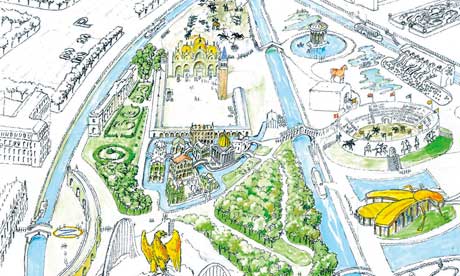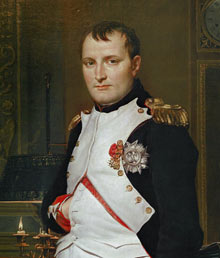Your own private Paris – Experience Paris like never before by living as the locals do.
Blog Archives
Travel Photo – March 8, 2012
Travel Article: Vive la révolution! French MP starts race to Napoleonland (The Guardian)
Vive la révolution! French MP starts race to Napoleonland
Yves Jego’s project is part of the latest quest by politicians on the French right to make their mark with theme parks
-
Angelique Chrisafis in Paris
- Tuesday 14 February 2012 15.57 EST
A French MP has laid down the gauntlet for a new generation of history-themed mega-rollercoasters with plans for Europe‘s first theme-park based on the French general and emperor Napoleon.
Dubbed “Napoleonland” and located about 40 miles from Disneyland on the outskirts of Paris, the project will formally launch this weekend with a race to court private foreign investors from Qatar to India, and a study to determine the exact nature of the technical wizardry of the rides that are hoped will tempt visitors from UK to China.
More than just the latest step of a hybrid of history and leisure known as “histo-tainment”, the tribute to one of French history’s most complex and contentious figures is part of the latest quest by politicians on the French right to make their mark with theme parks.
Yves Jego of the centre-right Parti Radical is a former minister in Sarkozy’s government, and the local MP for Montereau, the site of one of Napoleon’s last victories. He has described the project as his “life’s work”. Technicians and designers will set to work studying his dream rides to see whether his fantasy gimmicks and Napoleon experiences, recently outlined in his blog, are workable.
Detailed in the first drawings of the imagined park, Jego’s ideas include a Revolution experience where visitors will be “freed from the Bastille” and, while “trembling”, witness the guillotining of the king. Through French formal gardens and a 3D reconstruction of the palace of Versailles, visitors will be able to attend Napoleon’s crowning of himself as emperor.
A ride based on his Egypt campaign will send people plunging underground into a mock-up of the pyramids. The battle of Trafalgar will be re-enacted in a big aquarium and witnessed from under water. A Caribbean corner might feature the empress Josephine and a slave plantation.
One of the most bold imaginings, however, is for the coldest moments of Napoleon’s struggles: a dry ski-slope of his crossing the Alps, or a recreation of his disastrous retreat from Russia, re-enacting the crossing of the Beresina river past “frozen corpses of soldiers and horses”.
Austerlitz and Waterloo could also be represented. “Hear the shattering sound of the cannons, tremble when you feel the bullets whistle past your ears, breathe the smell of gunpowder, and admire Napoleon’s sang-froid,” wrote Jego.
Jego told the Guardian that all his bold imaginings would be part of a series of proposals examined by experts who would decide exactly how the rides shape up. “This is a project never been seen before. Napoleon is the best-known French figure in the world. He’s someone who in 15 years changed the history of the world. In two centuries, 80,000 books have been written about him. Yet we don’t have a dedicated museum to him in France.”
Asked about the contentious nature of Napoleon in France, he said he was not setting out to push a view of Napoleon, but to look at all aspects. “I want to reconcile history and the future,” he said.
Nicolas Sarkozy, once described as “Bonaparte in a suit” by one of France’s best known-political commentators, has often been likened to the frenetic, propagandist Napoleon for his perpetual motion, temper, initial reformist promises, which a majority of French feel have not been delivered, and his media campaigns. A recent study by a historian claimed that in times of crisis and uncertainty, France often looks back to the strong characters of its history.
The presence of Sarkozy’s tourism minister at the launch of the theme-park project this weekend cements the state’s approval on what Jego called an ambitious anti-crisis measure to create 1,000 to 2,000 jobs. But the €250m funding needed will come only from private investors who will be lobbied from next week.
Jego pitched his mix of “serious and fun” theme-park as the ultimate anti- crisis measure, saying only vast projects like this could “kickstart” the ailing French economy. If funding is secured, building could start in 2014. The park would not open until after 2017.
France’s leisure and theme parks attract between 55 and 70 million visitors a year, including 15 million to Disneyland Paris, which is Europe’s leading attraction.
Napoleon-land doesn’t hope to compete with Disney; its rival will be the nearby symbol of Frenchness, Parc Asterix, which pulls in 1.8 million. The Puy du Fou themepark in western France, set up by the rightwing politician Philippe de Villiers, attracts 1.4 million to its medieval re-enactments and Viking extravaganzas.
Historians, many already critical of Sarkozy’s use of historical references and sceptical of his plans for a great museum of French history, will be watching the project keenly.
The historian Nicolas Offenstadt noted: “History doesn’t just belong to academics. There is growing use of popular history – battle re-enactions, medieval villages or trench experiences – across the world. It shows that in a difficult modern times, people look to the past. But there must be a real effort to take historians’ advice so what is created isn’t idealised or mythologised.”
- © 2012 Guardian News and Media Limited or its affiliated companies. All rights reserved.














